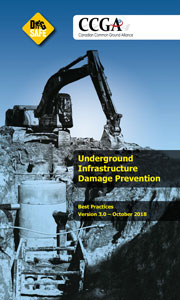CCGA Releases Best Practices Version 3.0
![]() Print this Article | Send to Colleague
Print this Article | Send to Colleague
 This set of National Harmonized Best Practices 3.0 – 2018, which has been updated through the commitment and consensus of its members working together toward a safer Canada, is part of an ongoing effort to develop new damage prevention practices as well as improve existing ones. These practices represent a dynamic statement of the type of activities that CCGA believes would provide optimum levels of diligence toward preventing damage to underground infrastructure. It is understood that not all stakeholders are presently in a position to adopt all of these practices, however, it is anticipated that progress will be made toward following these practices over time.
This set of National Harmonized Best Practices 3.0 – 2018, which has been updated through the commitment and consensus of its members working together toward a safer Canada, is part of an ongoing effort to develop new damage prevention practices as well as improve existing ones. These practices represent a dynamic statement of the type of activities that CCGA believes would provide optimum levels of diligence toward preventing damage to underground infrastructure. It is understood that not all stakeholders are presently in a position to adopt all of these practices, however, it is anticipated that progress will be made toward following these practices over time.
Download the CCGA Best Practices Version 3 here.
What’s new?
In 2017 and 2018, the CCGA added and amended multiple practices that appear in Version 3.0. The following modifications were approved by the Best Practices Committee and CGA Board:
- New Practice 3-23, Alternative Locate Method(s)
- New Practice 3-24, Electronic and Paper Locate Report Format
- New Practice 6-1, Underground Infrastructure Owner Damage Prevention Program
- Modification to Practice 2-7, Voice Record of All Incoming Calls (renamed as Documented Record of All Locate Requests)
- Modification to Practice 2-16, Locate Request
- Modification to Practice 2-26, All Buried Facility Owners are Members of the Notification Service
- Modification to Practice 2-27, Excavators Contact the Notification Service Before Excavating
- Modification to Practice 4-22, Relocate Request
- Modification to Practice 4-35, Pre-Demolition Verification Process
- Modification to Practice 5-1, Notification Service Responsibilities and Use of Mapping
- Modification to Practice 5-2, Locator Responsibilities and Use of Mapping
- Modification to Practice 5-4, Owner Responsibilities for Mapping Records


